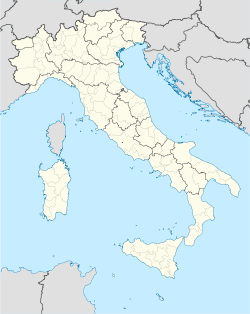- Nonantola
-
Nonantola — Comune — Comune di Nonantola 
Coat of armsLocation of Nonantola in Italy Coordinates: 44°41′N 11°02′E / 44.683°N 11.033°ECoordinates: 44°41′N 11°02′E / 44.683°N 11.033°E Country Italy Region Emilia-Romagna Province Modena (MO) Frazioni La Grande, Casette, Campazzo, Bagazzano, Rubbiara, Redù, Via Larga Government - Mayor Pier Paolo Borsari Area - Total 55 km2 (21.2 sq mi) Elevation 20 m (66 ft) Population (May 31, 2006) - Total 14,022 - Density 254.9/km2 (660.3/sq mi) Demonym Modenesi Time zone CET (UTC+1) - Summer (DST) CEST (UTC+2) Postal code 41015 Dialing code 059 Patron saint St. Sylvester Saint day December 31 Website Official website Nonantola is a city and comune in the province of Modena in the Emilia-Romagna region in northern Italy. It is located about 10 km from Modena on the road to Ferrara.
History
Nonantola's history is strongly connected to that of Nonantola Abbey a Benedictine monastery, founded in 752 by the Lombard duke of Friuli, St. Anselm, which supplanted the old Roman colony. It was richly endowed by King Aistulph; of the latter's edifices only traces remain. Pope Stephen II appointed Anselm its first abbot, and presented the relics of St. Sylvester to the abbey, named in consequence S. Sylvester de Nonantula. After the death of Aistulph (756), Anselm was banished to Monte Cassino by the new king, Desiderius, but was restored by Charlemagne after seven years.
In the High Middle Ages Nonantola held some importance, as it was chosen for the meeting in 883 between Pope Marinus I and the emperor Charles the Fat. Pope Hadrian III was buried here.
In the year 890 the city and the monastery were devastated by Hungarian marauders. Later Nonantola's history is connected to that of the monastery.
Up to 1083 it was an imperial monastery, and its discipline often suffered severely on account of imperial interference in the election of abbots. In the beginning of the Conflict of Investitures it sided with the emperor, until forced to submit to the pope by Mathilda of Tuscany in 1083. It finally declared itself openly for the pope in 1111. In that year Placidus of Nonantola wrote his De honore Ecclesiæ, a defence of the papal position during the Conflict of Investitures. It is printed in Bernhard Pez, "Thesaurus Anecdot. noviss." (Augsburg, 1721), II, ii, 73 sq.
It decayed badly from the 13th century onwards; the final decline of the monastery began in 1419, when it came under the jurisdiction of commendatory abbots.
The city was disputed between Modena and Bologna until it fell under Este's suzerainty (as an autonomous commune) in 1412. A constitution was issued in 1419. Nonantola remained a pacific agricultural centre well into the 17th century, when it had several urbanistic renovations.
In 1514 the abbey came into the possession of the Cistercians, but continued to decline until it was finally suppressed by Clement XIII in 1768.
Pius VII restored it 23 January 1821, with the provision that the prelature nullius attached to it should belong to the Archbishop of Modena.
In the Napoleonic Wars the abbey lost all its territories, which were acquired by the count Leonardo Salimbeni. His palace was sold to the comune of Nonantola in 1898, becoming the Town Hall. In this age the agriculture started dying out, as the Modenese nobles used archaic methods of cultivation, and industries, trade and water were lacking.
During the German occupation in World War II the Nonantolani hosted 73 Jewish children, enabling them flee to Switzerland. The city was awarded a Cross of War Medal for Military Valour for this feat and for its contribution to the Italian resistance movement.
Today Nonantola has achieved renowned status as an increasingly important cultural and tourist resort.
Main sights
Nonantola contains several remains from the Middle Ages. These include the two towers called dei Modenesi and dei Bolognesi, and the Pieve of S. Michael Archangel (9th century).
The main monument, however, is the famous abbey of San Sylvester, a Romanesque monument erected from the 8th century onwards.
References
 "Nonantola". Catholic Encyclopedia. New York: Robert Appleton Company. 1913.
"Nonantola". Catholic Encyclopedia. New York: Robert Appleton Company. 1913.
 This article incorporates text from a publication now in the public domain: Herbermann, Charles, ed (1913). "Nonantola". Catholic Encyclopedia. Robert Appleton Company.
This article incorporates text from a publication now in the public domain: Herbermann, Charles, ed (1913). "Nonantola". Catholic Encyclopedia. Robert Appleton Company.Emilia-Romagna · Comuni of the Province of Modena Bastiglia · Bomporto · Campogalliano · Camposanto · Carpi · Castelfranco Emilia · Castelnuovo Rangone · Castelvetro di Modena · Cavezzo · Concordia sulla Secchia · Fanano · Finale Emilia · Fiorano Modenese · Fiumalbo · Formigine · Frassinoro · Guiglia · Lama Mocogno · Maranello · Marano sul Panaro · Medolla · Mirandola · Modena · Montecreto · Montefiorino · Montese · Nonantola · Novi di Modena · Palagano · Pavullo nel Frignano · Pievepelago · Polinago · Prignano sulla Secchia · Ravarino · Riolunato · San Cesario sul Panaro · San Felice sul Panaro · San Possidonio · San Prospero · Sassuolo · Savignano sul Panaro · Scandiano · Serramazzoni · Sestola · Soliera · Spilamberto · Vignola · ZoccaCategories:- Cities and towns in Emilia-Romagna
- Communes of the Province of Modena
Wikimedia Foundation. 2010.

